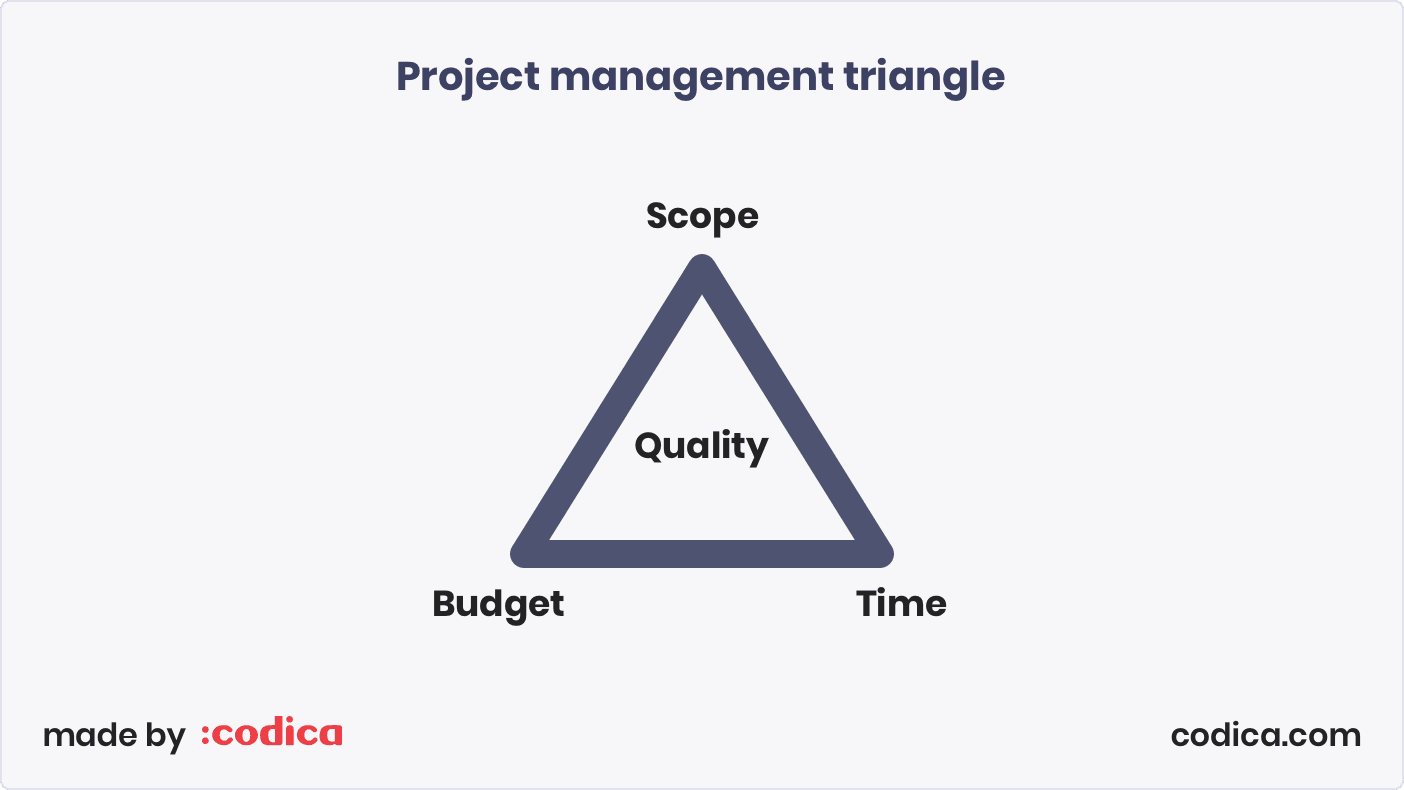Working as a Project Manager can be challenging. You need to be able to manage your team’s workload and your own as well. A professional PM always knows what’s going on and is constantly in touch with all customers, and is responsible for the overall project success. This may sound overwhelming, but it is possible to manage everything and survive!
In this article, Codica’s Lead Project Manager - Anton - shares his own experience. He gladly gives tips on how to survive in an endless stream of information, always reach the goals set, and win your team’s respect.
Let’s dive in!
Who is a Project Manager?
What does a Project Manager even do? Do we need them at all?
Some people can ask these questions, but only those who are not familiar with a PM’s role in the software development process.
What issues does a Project Manager handle every day?
- Diverse projects and a constant flow of various tasks.
- Communication, communication, and some more communication.
- High responsibility for several projects or even teams.
- A lot of things to do every day, such as organizing meetings, answering a great number of emails and calls, explaining tasks to your co-workers.
- Choosing the best methods to achieve the goals.
- Extremely busy days and late-night evenings.
- Tasks that need to be done before deadlines.
- Successful launch of long-awaited products.
Let’s look at the definitions:
Project management is the set and application of skills, tools, knowledge, and techniques to accomplish the project requirements. Project management structures the project’s development, as it falls into several steps: initiating, planning, executing, monitoring and controlling, delivering, and supporting. Its main goal is to provide the final success of the project.
Project managers are team players who plan, organize, control and coordinate the process. They have an exceptional entrepreneurial and flexible mindset. Needless to say, PMs are constantly improving their own and the teams’ professional skills, always ready to take a challenge and be responsible for their decisions. Passionate about their job, they inspire and support the team, enjoy the process, and lead to the result.
A well-known project management triangle describes a PM’s responsibilities best:

The final goal is to maintain the perfect balance between the scope, time and budget, to provide high quality. So, this is what the project manager is doing most of the time - looking for this balance.
As for Codica team, we add one more important triangle in the work of the PM. We call it people-oriented PM triangle.

We believe that the second triangle is about high-level importance. Keep the balance in it, and you will easily achieve the balance in the first one as well.
Start your day actively
Since the geography of our projects stretches from Australia to the United States, it’s really important to start a morning actively, energize, and get the most of your workflow.
Check your messages in the morning
In the morning check Slack or another tool you use to be aware of your team’s needs. It helps to plan a day a lot.
Physical activity is important
Train your body before an intensive work: visit the gym nearest to the office to be productive and inspired.
Plan your day and be positive
Sip your coffee or tea, talk to your team members, listen to your favorite music and smile.

The cup says: Anton is a problem-solver
Personal tip: Check emails and messages from your customers in the morning and make urgent requests a priority. This habit is a great time-saver.
Keep your email organized
As the Lead Project Manager at Codica, Anton keeps control over 10-12 projects at different stages, so there are a lot of things to do, including emails.
Often, clients send quite complex and time-consuming requests. Thus, analyzing incoming messages takes rather an impressive part of the working day as it is not always possible to quickly read and respond to them.
Below you can find some valuable advice that will help you to stay more organized.
Manage notifications
Don’t lose concentration working with multiple task trackers: set up forwarding of notifications to your email Inbox. Now, you can structure the flow of information with no effort.
Set the time for checking your Inbox
Check your Inbox at least 3 times a day. However, if you are waiting for a high-priority email from a customer, check incoming messages more often to be sure you don’t miss it.
Write clear email subjects
Follow the principle “If possible, let customer not even open your email”: Write the most important information in an email subject to save the time of your customers and find the email faster.
Don’t lose valuable email messages
Leave important emails unread or bookmark them.
More devices = more flexibility
Sync the tools you use to your Google account and reach them from any device you use, wherever you are. It helps to be more flexible.
Filters can make life easier
Filter Inbox from task trackers by the project. It helps to quickly get updates on more important and high-priority tasks.
Personal tip: There can be times when you need to send a lot of emails. LOTS of emails. Our advice is to save email drafts with important ideas. When it’s time to send a message, just re-read it and add final thoughts into it. Done!
Set up effective communication with your team and customers
Daily meetings are an essential part of the workflow. It’s the perfect time to find out how your teams are doing, what happened yesterday, and what needs to be done today. Since Codica consists of two teams, these daily meetings take about 40 minutes a day. During such meetings we update the status on each project, outline possible difficulties, draw up a list of questions for the customer if there are any.
Apart from the daily meetings, our team members often discuss working issues while playing tennis or mini-basketball, waiting for a cup of coffee in the kitchen or sitting on a cozy sofa.
Related reading: How to Get Your Team to Estimate Better in 3 Simple Steps
The following tips will help you get the best results.
Prepare for each meeting
It’s your job to always be informed and comprehensive.
Let everyone else prepare for a meeting
Inform your co-workers about the agenda for them to get ready for the meeting and answer your questions. Share any important information with the team in advance.
Be brief
Try to stick to the agenda and use the time to the full, making meetings as brief as possible.

Don’t be afraid to ask for help
Remember: The most initiative developers are your best friends. They surely help you to find out the ways to get more effective results.
Follow-ups are extremely important
Send a follow-up to everyone using the most convenient communication tool after each daily meeting. So that everyone in the company may see the goals set for the day, and tasks to be completed.
A meeting or an email?
Everyone knows a golden rule: You should better escape a meeting if you can. Instead of a meeting, write an overall email to your teammates or clients, and you will surely get the same results.
Personal tip: Schedule your meetings, set their duration, and do not go beyond it. It’s easier than you think.
Keep track of your projects' statuses
When all incoming requests are processed and tasks are distributed, it is time to update the boards and projects backlogs.
It is necessary to keep an eye on all the project boards, view updates, make sure that tasks statuses meet the reality.
Our tips will help you make these daily routines flawless.
Setting goals does magic
Use Trello board to fix weekly goals. To achieve the objective, we set one important goal per week to each project.
Manage your resources wisely
Apply planning techniques to rationally use your time resource and have the maximum benefit from this process.
You may also like: How Slack Bot Helps Us With Time Tracking
At Codica, we always aim to deliver the most valuable features in a shorter period of time. That’s why we make quick wins a priority.

Personal tip: Write Time Reports every day and send them to your clients once a week. Time reports are so specially loved as they give our customers transparency of features implemented and help them to plan their budget.
Never stop learning
Dealing with complex queries is Anton’s favourite part of the workday.
Waking up in the morning, you never know what kind of a request you will get today. It may be a task for a couple of hours (i.e. add a new field to the form) or several days (i.e. add a new payment option), or you may start a several months project.
Anton always gains insights into every issue. It’s his job to find out what business goal the customer is looking to achieve with a feature, and suggest the best options.
The below tips will help you.
Always be up-to-date
Research the latest industry trends, read professional resources in your field.
Know customer’s business better
To find out the main point of the project, explore the market for a better understanding of the functionality that should be implemented.
Don’t forget about customer's competitors
Google customer’s services and read the news on alike topics to find out more about the competitors.
Analyze the project’s track activities
Use the most popular analytics tools, such as Google Analytics and Hotjar. It helps to learn more about project statistics.
Involve your team
Write down all the project-related questions and discuss them with your team.

Personal tip: Study all the time and broaden your outlook. Find and read as much technical information about each project as possible.
Summing up
Project managers play an important role in the development process as they build the communication between the customers and the company. Working as a PM means to take care of the projects, budget, and your clients’ interests, your team members and their motivation.
Working as a project manager can be challenging, however, with the right approach and skills, anyone can succeed.
Good luck with your projects and may the force be with you!
Further reading: Agile at Codica: How We Deliver Great Web Products
